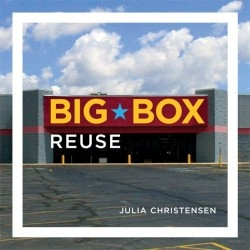Big Box Reuse
Across America, “big box” stores rise like bland jewels in settings made just for them—huge parking lots and highways built or diverted to direct traffic flow. With the landscape so altered, what happens when a chain abandons a store to build a larger one nearby? Julie Christensen’s Big Box Reuse examines just that: adaptive reuse of Wal-Marts and K-Marts by communities, business people, and city councils.
In ten chapters, Christensen describes ten examples of citizenry making sites over into charter schools, museums, libraries, a chapel, a justice center, a raceway, centers for health care, and a flea market. Christensen, an artist, researcher, and academic whose work has been featured in galleries and profiled in the New York Times, breaks out of field and genre to explore the process and product of such reuse. She frames each chapter as a case study, but mixes up the form by including personal details: “I think back to my childhood in Bardstown, Kentucky, where historically the city’s churches, hospitals, and most schools were within walking distance.”
The design of the book itself makes tangible the process of taking a received form and making it unique and specific: the book is square, and the generous page margins emphasize the shape—yet each page yields surprising details about the way people localize very globalized structures. In the chapter on the RPM Indoor Raceway, Christensen writes about the raceway as an attempt to, in the words of Austin’s city slogan, “Keep Austin Weird”: “The raceway’s commitment to this initiative is an interesting juxtaposition considering the commercial real estate that it attempted to absorb.”
It is a smart book, one that speaks to the zeitgeist: the ultimate form of recycling, after all, is recycling of place. But more than that, it is an enthusiastic book; Christensen clearly has affection for many of the thoughtful, community-building reuse projects. Of the Lebanon-Laclede County Library, Christensen says, “The care that has gone into the renovation of this site is clear to me from the moment I walk through the doors.”
True to form, Big Box Reuse is a book for many collections. It will easily appeal to art and architecture aficionados, environmentalists, city planners, cultural studies academics, and any intellectually curious person who shops at the big chains—though it’s very small font may pose an issue. Big Box Reuse is anything but bland.
Reviewed by
Aimee Houser
Disclosure: This article is not an endorsement, but a review. The publisher of this book provided free copies of the book to have their book reviewed by a professional reviewer. No fee was paid by the publisher for this review. Foreword Reviews only recommends books that we love. Foreword Magazine, Inc. is disclosing this in accordance with the Federal Trade Commission’s 16 CFR, Part 255.

